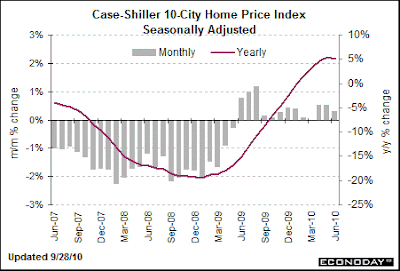From Elliott Wave International:
It is NOT the end of a bear market when:
1. Mutual fund cash holdings fall to just 3.4%, the lowest level in 60 years (previous extreme lows came in 2000 and 2007)
2. The Dow Industrials have a 2.7% annual dividend yield (a lower percentage than in 1929)
3. A major sentiment indicator shows 24.3% bears (fewer than Oct. 2007)
4. TRIN readings since the May 6 flash crash register .25 or lower for 21 trading days (readings this low indicate "buying panics")
5. The market sees trading volume rise during declines but not during rallies (which was true during the summer months and into September)
6. The city of Atlanta has a 21.2% commercial vacancy rate (2nd highest of major U.S. markets), yet owners of troubled properties claim to "remain optimistic"
7. This year has seen the sale of $4.4 billion in bonds which are tied to subprime auto loans (already more than 2x sales in 2009)
8. All the above (and more) is true, but the nation's financial newspaper of record posts a mid-day stock market summary with a quote from a top fund manager who says, "This as optimistic as I have been this year."
Comments:
The steady downward movement in the consumer sentiment reading alone should cause us concern. In May it was 62.7, now it is 48.5 and seems to be dropping.
The Case-Shiller home price index was dropping 10, 15, 20% on a year to year basis from 2007 until early 2009. More recently, thanks to government programs, it managed to make its way past zero in December 2009 to a 5% year to year increase in June. The bad news is that the government programs have ended, and we are beginning to see downward momentum in prices once again. Compounding the issue, we see increasing numbers of foreclosures that are due to soon hit the market.
It is my assertion, that as consumer sentiment drops further, thanks in part to chronically high unemployment, consumers will reduce spending further. This consumer behavior at some point is bound to spill over into reduced corporate earnings.
Lower earnings will make stocks look less attractive, and we will see further movements into bonds, cash, and gold.
Speaking of bonds and gold, we recently saw gold break $1300/oz and the gold to bond ratio approach the magic "10" level. If it persists above 10 for any length of time, we will see move movement down Exter's inverse liquidity pyramid.
This should be very bullish for cash and gold, and very bearish for real estate and stocks.



Comments
Post a Comment